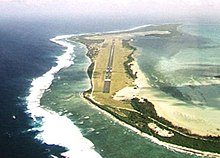Cocos Island Contingency Reception Center
The Cocos Island Contingency Reception Center was a temporary Australian immigration detention center located on West Island , one of the Cocos Islands . The camp was operated by the Australian government . So-called boat people who wanted to apply for asylum in Australia were arrested in this refugee camp in immigration custody.
Australian migration law
With the Migration Amendment (Excision from Migration Zone) Act 2001 , the Australian Parliament removed the outlying areas of Ashmore and Cartier Islands , Cocos Islands and Christmas Island , although Australian territories , from its migration zone . Boat people who land there cannot apply for asylum; on the contrary, they are committing a crime under Australian law and can be deported or taken into immigration detention at any time.
location
West Islands is a small island in the South Keeling Islands atoll far in the Pacific . The island is dominated by a runway that was of great strategic military importance during World War II .
Camp life
According to the Australian Human Rights Commission , the infrastructure of the refugee camp was not only underdeveloped, it was also completely unsuitable for long periods of residence. There was only a small clinic, a central lounge and a lounge on the airport grounds. Leisure activity was minimal on the island. There was no English language tuition whatsoever that was usually offered in such camps. Fishing and cooking on the island's beach were possible under observation.
There were no external contacts, neither were there newspapers, magazines or televisions. The inmates could not make phone calls. There was a phone only for the camp staff and the relevant Australian Ministry. There were two fax machines in this room. If an inmate wanted to fax his family or lawyer, he would have to pay for it. According to the Human Rights Commission, due to the lack of telephones for the inmates, not a single telephone interview could be conducted from Australia.
The camp was operated by a private service company, Australasian Correctional Management (ACM). Legal supervision of the camp was in the hands of an Australian ministry, the Department of Immigration and Multicultural Affairs (today 2009: Department of Homeaffairs ).
The warehouse building, which housed 131 inmates in January 2002, including 122 men, 4 women and 3 boys, including one unaccompanied boy and 2 girls. The building was originally a cattle quartet station. When the Human Rights Commission visited the camp on January 25-26, 2002, there were people from Vietnam and Sri Lanka . Camp inmates told the Human Rights Commission that some of them had been on the island for months. The Human Rights Commission assumed that camp inmates had been deported to the Nauru Regional Processing Center in Nauru and Manus Regional Processing Center in Papua New Guinea prior to their arrival .
Warehouse liquidation
It became known that in the course of the liquidation of the camp, 33 asylum seekers from Sri Lanka were returned to their home country and a further 62 people from Sri Lanka left the island on February 16, 2001 and were transported to the Christmas Island Immigration Reception and Processing Center on Christmas Islands .
The West Islands camp was abandoned in March 2002.
See also
Individual evidence
- ^ Federal Register of Legislation , 2001, on Australian government. Retrieved May 7, 2019
- ^ Australian Government. Department of Home Affairs . Retrieved May 7, 2019
- ^ A Report on Visits to Immigration Detention Facilities by the Human Rights Commissioner 2001 , dated 2002, to Australian Human Rights Commission . Retrieved May 7, 2019
